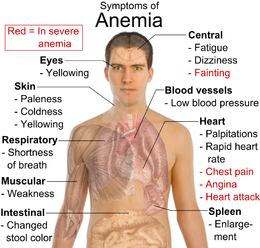The Upside to Being Anemic
Anemia is a common condition exhibited in one in four people around the world. In fact, 50 percent of all patients that visit hospitals for surgery are anemic. The condition has a multitude of causes, ranging from malnutrition, genetic mutation, pregnancy, infection and blood loss. All of the above listed causes inhibit red blood cell (RBC) production, increase RBC destruction, cause blood loss and cause hypervolemia (a condition in which the blood contains too much fluid).
The lack of RBC or hemoglobin resulting from this causes a problem for body tissue; all cells need oxygen for survival and energy to continue functioning, and without sufficient hemoglobin to deliver it, anemia can be a deadly condition to the bodily tissues.

There is good news for people afflicted by anemia, as researchers at St. Michael’s Hospital have discovered a new use for a previously known enzyme that has an additional function should the host be anemic. Neuronal nitric oxide synthase (nNOS), an enzyme present in the nerve cells of the brain, produces nitric oxide, which increases bodily response and improves adaptation to low levels of oxygen, increasing the body’s efficiency in oxygen delivery to the body.
“Identifying this mechanism may lead to new therapies and approaches to improving outcomes for anemic patients,” said Dr. Greg Hare, a researcher at the Li Ka Shing Knowledge Institute of the hospital and one of the lead investigators of the study.
The researchers at St. Michael’s Hospital monitored the nNOS levels in anemic mice. They found that the nNOS present in the brains of anemic mice was increased, and these mice outlived the mice without nNOS. This result proves most curious, as people that are afflicted by anemia are often associated with weakness and low energy, contrasting with the longevity of the anemic mice.

“This research will help us identify when an anemic patient is at greatest risk for injury and death when undergoing surgery,” said Dr. Hare. “Research is underway to test these findings in humans.”
Should this new discovery be introduced into surgical procedures of anemic patients, the nNOS levels can be monitored, which will serve as a warning signal to the surgical team should the anemic patient’s body encounter any complications. The effect of this finding is especially pronounced when the above statistic, 50 percent of all surgical patients suffer from anemia, and the fact that anemia can stem from a great variety of causes, is put in mind. The discovery of this new function of an enzyme only present in people suffering from anemia begs the question: Are there any other diseases or conditions that have enzymes and yield similar beneficial results? Can being afflicted by a disease or condition result in any advantages that are not yet discovered?
References:
“Anemia – Wikipedia, the free encyclopedia.” Wikipedia, the free encyclopedia. N.p., n.d. Web. 3 Oct. 2011. <http://en.wikipedia.org/wiki/Anemia
Taylor, Kate. “Our Stories – What’s New – Who We Are – St. Michael’s.” St. Michael’s. N.p., n.d. Web. 3 Oct. 2011. <http://www.stmichaelshospital.com/media/detail.php?source=hospital_news/2011/20111003b_hn>.
St. Michael’s Hospital (2011, October 3). Researchers discover new enzyme function for anemia. ScienceDaily. Retrieved October 3, 2011, from http://www.sciencedaily.com/releases/2011/10/111003151832.htm
October 15th, 2011 at 8:59 am
Really interesting post about some nice Canadian research. How did you find out about it and why did you find it interesting? I had always thought anemia meant low iron levels so it might have been helpful for readers to briefly explain what anemia is. I needed to look it up.
October 19th, 2011 at 3:02 pm
I found out about this in an online Science research news site: http://www.sciencedaily.com. I found it interesting because of the impact it could have on surgical procedures on anemic patients. Anemia actually has several different varieties. There are anemias of impaired Red blood cell (RBC) production, rapid RBC destruction (hemolytic anemia) among others. An iron deficiency would cause iron deficiency anemia, which would impair hemoglobin production. Anemia could also result from blood loss, which would explain the 50 percent anemia rate amongst surgery patients.